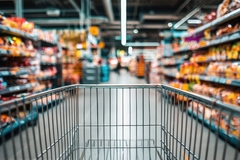
- Industry news
Industry news
- Category news
Category news
- Reports
- Key trends
- Multimedia
- Journal
- Events
- Suppliers
- Home
- Industry news
Industry news
- Category news
Category news
- Reports
- Key trends
- Multimedia
- Events
- Suppliers
Cargill CTO: How leveraging chemical engineering can solve the food industry’s biggest problems
Chemistry is playing an increasingly fundamental role in modern food product development, from fermentation-based sweeteners and microbiome-enabled nutrition to regenerative agriculture and precision protein development. Cargill’s CTO, Florian Schattenmann, sits down with us to discuss the latest chemistry-driven F&B advancements and what they mean for the industry’s future.
Schattenmann was recently named a 2025 Fellow of the American Chemical Society (ACS) — a recognition that underscores the growing and mutual influence between the F&B and scientific engineering industries.
Schattenmann’s work has addressed some of the most urgent problems facing the food industry: reducing sugar and salt without compromising taste, enabling traceable and sustainable protein systems, leveraging data to boost animal and crop health, and creating value from bioindustrial side streams.

In this interview, Schattenmann reflects on his path from academic chemistry to leading innovation at one of the world’s largest agrifood companies — and outlines where he sees the most promising developments for the future of food.
What drew you from chemistry into food innovation, and how has that shaped your approach at Cargill?
Schattenmann: I started in inorganic or organometallic chemistry specifically, but the real draw for me has always been applying science in ways that tangibly improve people’s lives. Whether it was working on electronic materials or polymers in automotive early in my career, or now helping deliver more nutritious, sustainable, and accessible food — I’ve always gravitated toward innovation with real-world impact. The key is to be in an area that is ripe and open to innovation at a given time.
When I joined Cargill, what excited me was the opportunity to bring together deep scientific expertise, global scale, and the immediacy of food. The challenges are immense — climate change, food security, nutrition — but so is our potential to make a difference. My approach is shaped by that tension: we need both breakthrough science and practical solutions that scale. That’s where chemistry, engineering, biology, and food science intersect — and where we have a real chance to move the needle.
Among the technologies Cargill is scaling — like fermentation-based sweeteners and microbiome tools — what do you see as most transformative?
Schattenmann: It’s hard to pick one, but I’d say targeted fermentation continues to stand out. It’s a capability that cuts across categories—from sweeteners to dairy proteins to postbiotics like EpiCor. Take EverSweet, developed through our joint venture with dsm-firmenich (Avansya), for example. EverSweet is a next-generation stevia sweetener made via precision fermentation, delivering the sweetest parts of the stevia leaf, but with 96% less land impact and 97% less water use. That’s not just an R&D win — it’s changing how we think about ingredients, supply chains, and sustainability.
 Schattenman’s path from chemical research to F&B development has helped inform Cargill’s approach to NPD.We’re also leaning into the microbiome space in a big way — Reveal Layers uses innovative, non-invasive Near-InfraRed technology to give producers and nutritionists immediate access to body composition assessments of their hens. This allows them to make real-time decisions regarding diets to support their flocks’ long-term production and performance.
Schattenman’s path from chemical research to F&B development has helped inform Cargill’s approach to NPD.We’re also leaning into the microbiome space in a big way — Reveal Layers uses innovative, non-invasive Near-InfraRed technology to give producers and nutritionists immediate access to body composition assessments of their hens. This allows them to make real-time decisions regarding diets to support their flocks’ long-term production and performance.
Similarly, Galleon Microbiome Intelligence helps farmers monitor the health of their flocks’ microbiomes to drive management decisions. These innovations help us move from treating symptoms to proactively supporting health of animals, people, and even soil. That’s the kind of systems-level thinking we need more of.
How is Cargill applying regenerative agriculture in practice, and what kind of impact are you seeing?
Schattenmann: Regenerative agriculture is about improving soil health, increasing resilience, and creating more value for farmers. To help farmers and ranchers make the transition to regenerative practices with confidence, Cargill provides support through a combination of financial incentives, inputs and on-the-ground training from expert agronomists.
Through programs around the world like SustainConnect, ReSolu and Cargill RegenConnect, we help farmers improve their soil health, boost production and reduce input costs. What we’re seeing is encouraging. But it’s not just about agronomics — it’s also about enabling farmers to participate in the broader bioeconomy. That means turning waste streams into animal feed, upcycling materials, and connecting the dots between sustainable practices and economic opportunity.
What’s driving your R&D focus across proteins, sugar/salt reduction, and bioindustrial ingredients?
Schattenmann: Three things: consumer (and customer) demand, the shifting global landscape, and scientific possibility.
Consumers want more protein — but they also want options. That’s why we’re taking an inclusive approach across animal, plant and fermented proteins. And we’re investing to keep exploring the future of what protein-packed foods could reflect that commitment.
On sugar and salt, as well as fats the demand for reduction is clear — but taste still rules. That’s why we’ve spent over a decade developing solutions like EverSweet and our portfolio of enhanced salt systems. We’ve helped remove over 1.5 billion pounds of iTFAs and 2.8 billion pounds of sugar from the global supply — without compromising taste or functionality.
And on bioindustrial, we’re asking: how do we make every molecule matter? From renewable lubricants to beauty ingredients like BotaniDesign — a 100% naturally derived, plant-based, biodegradable alternative to petroleum jelly that is included in a range of personal care products — we’re scaling science that connects food, feed, fuel, beauty, and beyond.
How do you see chemistry’s role evolving in tackling global food challenges?
Schattenmann: Chemistry is often called ‘the central science’ as it forms a bridge between the physical and the life sciences. Understanding chemistry on a molecular level rather than trial and error will be more and more central to innovation. But it’s not just about molecules — it’s about systems thinking. Today’s chemists work with scientists and engineers alongside data scientists, agronomists, and AI engineers to reimagine how we grow, move, and deliver food.
Whether it’s turning starch into better emulsifiers, optimizing food formulations using computer models, creating smart nutrition for animals, or rethinking supply chains to be circular instead of linear, chemistry is the great enabler. That’s the kind of transformation we need to meet global challenges head-on.
What excites you most about the future of food science?
Schattenmann: The convergence. For example, we’re seeing biology, chemistry, AI, and behavioral science come together in ways that just weren’t possible five or ten years ago. With tools like generative AI and multi-omics, we can now go from idea to formulation to market faster and more precisely than ever before.
I’m especially excited about food that meets people where they are — culturally, nutritionally, emotionally. Science is catching up to the complexity of human needs. Whether it’s personalized nutrition, microbiome-linked mental health, or climate-resilient ingredients, the future of food is not just about sustenance — it’s about possibility.











